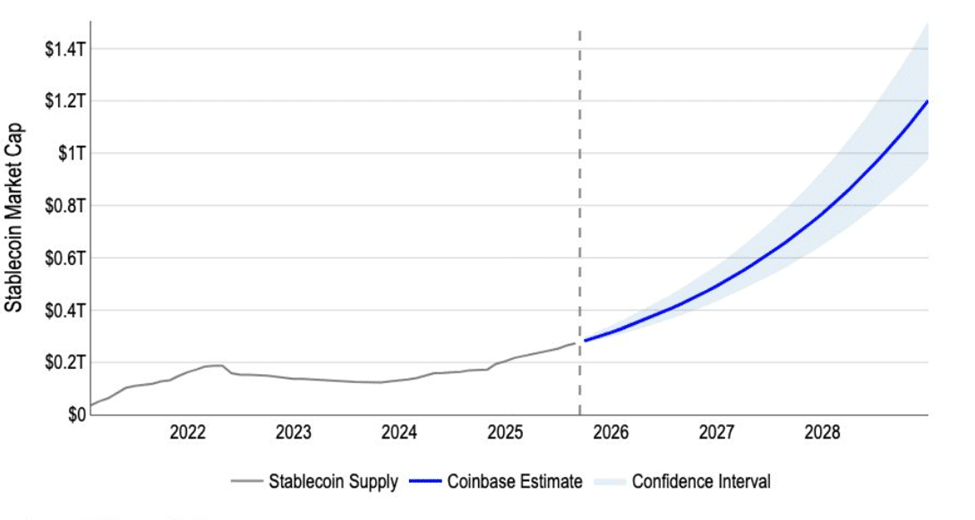
New projections from Coinbase suggest that the stablecoin sector could reach $1.2 trillion by 2028.
However, this significant growth raises questions about the effects on U.S. Treasury yields and global liquidity.
Coinbase projects a $1.2 trillion stablecoin market by 2028
The forecast emerges as the stablecoin market progressively becomes one of the most critical battlegrounds in global finance.
David Duong, head of research at Coinbase, detailed the company’s methodology, using 20,000 Monte Carlo simulations based on an autoregressive process (AR(1)) to forecast growth.
Based on the team's findings, stablecoins could leap from the current market capitalization of $275 billion to $1.2 trillion in just three years.
“This is not a ‘random’ forecast… Growing from $275 billion today to $1.2 trillion implies approximately $925 billion in net issuance of U.S. Treasury securities over about 175 weeks — or about $5.3 billion per week,” explained Duong in his analysis.
In addition to highlighting the popularization of stablecoins, such a trajectory underscores their growing role in global financial stability.
 Coinbase Stablecoin Projection. Source: David Duong on LinkedIn
Coinbase Stablecoin Projection. Source: David Duong on LinkedIn
Experts react amid expected pressure on Treasury yields
Coinbase's model suggests that an influx of $3.5 billion in stablecoins could compress three-month Treasury yields by two basis points (bps) within 10 days and up to four bps in 20 business days.
This is because stablecoin issuers (like Circle and Tether) typically use a large portion of their reserves to buy short-term U.S. Treasury securities like 3-month T-bills to earn yield while maintaining high liquidity and safety.
However, bond prices and yields move inversely. As stablecoin issuers buy more T-bills, the price rises, but the yield falls.
Although these effects may dissipate within weeks, the structural implications are significant. However, Duong clarified that the response is not exponential.
“It is important to note that the response decays — the effects do not accumulate indefinitely. Trillions of dollars in money market funds may reallocate between T-bills and the Fed's overnight reverse repurchase facility, establishing an effective floor for overnight rates,” he added.
While the Coinbase executive sees stablecoins as a threat to U.S. Treasury securities, Treasury Secretary Scott Bessent disagrees.
According to Bessent, stablecoins could help increase demand for U.S. Treasury securities. He stated that the crypto industry will become a crucial buyer of bonds in the coming years. Bessent's forecast depends on Washington's efforts to boost demand for new U.S. government debt.
“Bessent signaled to Wall Street that he expects stablecoins, digital tokens backed by high-quality securities like those from the Treasury, to become an important source of demand for U.S. government bonds,” reported the Financial Times citing people familiar with the matter.
Market experts weighed in on the projection. Eric Turner, CEO of Messari, highlighted current growth trends and considered the estimate of $1.2 trillion plausible.
“$1.2 trillion seems quite reasonable, if not conservative, based on what we've seen in 2025,” wrote Turner.
Similarly, Jordan Lawrence, CEO of Damisa, praised Coinbase's use of simulation modeling and highlighted the importance of examining the impacts on yields alongside regulatory changes.
Meanwhile, Ben Lavi, CEO of RGG, emphasized that stablecoin issuers must evolve beyond transactional utility to sustain returns. However, Lavi predicts that sharing yields with clients will become inevitable.
“For the stablecoin market to reach a value of $1 trillion, and even more, they will need to offer much more than just the ability to transact. Eventually, I project that the ROI for Tether and Circle will be the same as it is today because they will need to share the ROI with their clients,” stated Lavi.
Between JPMorgan's skepticism and the Treasury's trillion-dollar optimism
Coinbase's projection sits between more cautious and more aggressive forecasts. Recently, JPMorgan warned that the market might only reach $500 billion by 2028, citing limited adoption beyond crypto trading and DeFi.
Their report noted that 88% of stablecoin activity still occurs within crypto ecosystems, while only 6% is linked to real-world payments.
In contrast, the U.S. Treasury and Standard Chartered are much more optimistic. Treasury forecasts suggest a $2 trillion market by 2028, driven by institutional adoption, financial asset tokenization, and merchant integration.
Standard Chartered also forecasts a $2 trillion increase, driven by new U.S. legislation under the GENIUS and STABLE Acts, which will impose stricter transparency and reserve requirements.
Adding to the optimism, MEXC COO Tracy Jin predicts that stablecoins could surpass the $2 trillion mark as early as 2026.
In a statement to BeInCrypto, the crypto executive cited strong demand amid macroeconomic uncertainty and rapid growth in DeFi, cross-border payments, and digital asset trading.
Regardless of which projection proves correct, stablecoins are becoming a central pillar of modern finance. They already process trillions in transaction volume and dominate institutional OTC crypto trading, now representing nearly 75% of the activity.
Their expansion into payments, merchant networks, and tokenized assets could weave them even more into the global financial system.
However, even in the face of this perceived growth, the path is marked by challenges. The Italian Minister of Economy warned that U.S.-backed stablecoins could challenge European monetary sovereignty.
“The overall focus right now is on the impact of trade tariffs. However, the new U.S. policy on cryptocurrencies is even more dangerous, particularly regarding dollar-denominated stablecoins,” reported Reuters, citing Giancarlo Giorgetti.
In this context, accelerated efforts to launch a digital euro could hinder the growth of dollar-backed stablecoins.
The question is no longer whether stablecoins will scale, but how they will reshape financial markets. Coinbase’s $1.2 trillion trajectory is plausible and consistent with Treasury dynamics.
However, policymakers say the challenge will be balancing innovation with stability as stablecoins grow from niche crypto tools to systemic financial instruments.
Will the market come closer to JPMorgan's $500 billion, Coinbase's $1.2 trillion, or the Treasury's $2 trillion? The outcome, whatever it is, will influence bond markets, banks, and regulators.
The article 'Stablecoins Could Disrupt Bond Markets, Says Coinbase' was first seen on BeInCrypto Brazil.

